
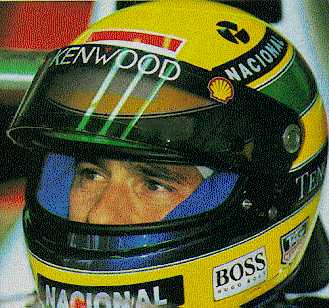
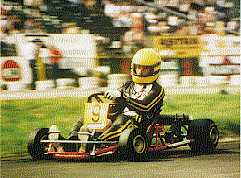 Ayrton
Senna began racing at a very early age, he was four. His karting
experience led him into the British Formula Ford 1600 series, on
to the European Formula Ford 2000 series, the British Formula 3
series and then into Formula1. He had won every series on his way
to Formula1 and had tested with Williams and McLaren. His debut
however was made with the Toleman (Benetton) team in 1984. He
impressed a lot of people with his first season, second in Monaco
and third in Britain. He had set the fastest lap in Monaco and was
catching race leader Alain Prost when the race was stopped due to
the rain. In 1985 he managed to release himself from his contract
and join Lotus.
Ayrton
Senna began racing at a very early age, he was four. His karting
experience led him into the British Formula Ford 1600 series, on
to the European Formula Ford 2000 series, the British Formula 3
series and then into Formula1. He had won every series on his way
to Formula1 and had tested with Williams and McLaren. His debut
however was made with the Toleman (Benetton) team in 1984. He
impressed a lot of people with his first season, second in Monaco
and third in Britain. He had set the fastest lap in Monaco and was
catching race leader Alain Prost when the race was stopped due to
the rain. In 1985 he managed to release himself from his contract
and join Lotus.
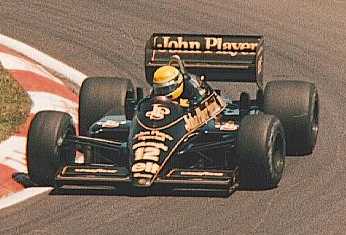 The
team had won only one race since 1978 and were in a state of
decline from their sixties heyday. Ayrton gave them a new lease of
life. He won his first race at Estoril in heavy rain. He had also
started from pole and set the fastest lap. It was the beginning of
a pattern. Ayrton won once more that year, in Spa. Perhaps the
most impressive thing about his first year with Lotus was the
seven pole positions that he gained. Staying with Lotus for 1986
he again won twice. Spain and Detroit. He finished in the points
every time he completed a race and only failed to make the podium
twice. But for six retirements he may have had a good chance of
his first championship. As it was he finished fourth 17 points
behind the winner.
The
team had won only one race since 1978 and were in a state of
decline from their sixties heyday. Ayrton gave them a new lease of
life. He won his first race at Estoril in heavy rain. He had also
started from pole and set the fastest lap. It was the beginning of
a pattern. Ayrton won once more that year, in Spa. Perhaps the
most impressive thing about his first year with Lotus was the
seven pole positions that he gained. Staying with Lotus for 1986
he again won twice. Spain and Detroit. He finished in the points
every time he completed a race and only failed to make the podium
twice. But for six retirements he may have had a good chance of
his first championship. As it was he finished fourth 17 points
behind the winner.
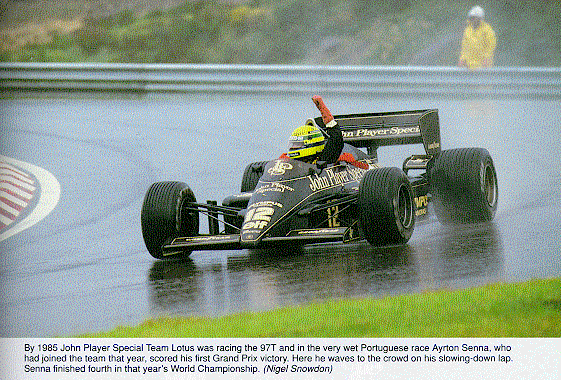
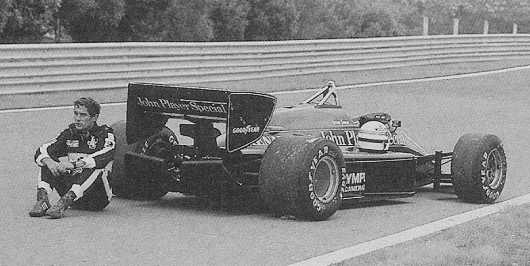
In 1987 Lotus were given Honda engines and again Ayrton scored two wins. This time in Monaco and Detroit. The Monaco win would become something of an annual event. Six other podium finishes helped him into third place in the championship. With only three retirements though it was clear to Ayrton that the Lotus car was not up to the job of allowing him to win the championship.
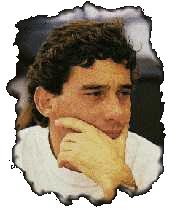
"Things bring you to reality as to how fragile you are; at the
same moment you are doing something that nobody else is able to
do. The same moment you are seen as the best, the fastest and
somebody that connot be touched, you are enormously fragile.
Because in a split second it's gone."
......Ayrton Senna, taken from Car magazine
Champion Of The World
![]()
In 1988 Ayrton joined McLaren, moving to the team at the same time as the Honda engines. In his first year with the team he scored thirteen pole positions and won a (then) record eight races in a single season. He won the championship by three points from his team mate Alain Prost.

Controversy On And Off The Track
In 1989 Ayrton suffered mixed fortunes, he retired in Phoenix, Canada, France, Britain, Italy, Portugal and Australia. In Brazil he was involved in a collision and ended up 2 laps behind after making four pit stops. With the exception of Hungary where he came second behind Mansell and Japan where he won but was disqualified, Ayrton won every race that he finished. The Japanese race will be remembered for Senna colliding with Prost on lap 47. Prost went out and although Senna won, he was disqualified for receiving a push start and not rejoining the circuit correctly. This handed the title to Prost. In 1989 the best 11 results counted and six wins and one second place were enough for him to finish second.
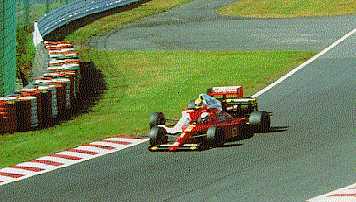 In
reality this whole situation was caused BY the FIA, during the
Senna versus Prost rivalry of the late eighties. Race analysis of
the first collision in 1989 at the Japanese GP (including an
overhead helicopter camera shot!) , showed Prost executing what
now be could be called perfect "Schumacher manoeuvre", hitting
Senna several yards away from the normal turn-in in point of the
corner after the pits exit. Prost knew that if Senna got past him,
he would have no hope of catching him (in this case because of
Ayrton's unparalleled speed), so he too simply collected his car
and with it the World title.
In
reality this whole situation was caused BY the FIA, during the
Senna versus Prost rivalry of the late eighties. Race analysis of
the first collision in 1989 at the Japanese GP (including an
overhead helicopter camera shot!) , showed Prost executing what
now be could be called perfect "Schumacher manoeuvre", hitting
Senna several yards away from the normal turn-in in point of the
corner after the pits exit. Prost knew that if Senna got past him,
he would have no hope of catching him (in this case because of
Ayrton's unparalleled speed), so he too simply collected his car
and with it the World title.
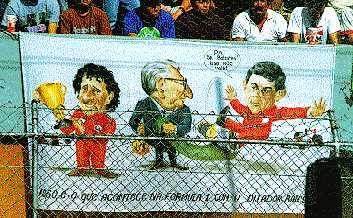
The FIA, headed notoriously by J. M. Ballestre, Prost's fellow
countryman, proceeded to shift attention away from Prost's tactics
by disqualifying Senna and charging him with misconduct in earlier
races ....... a questionable approach at least! This handed the
title to Prost (an act that wa repaeated 5 years later in
1994, with Schumacher the benefactor and Hill the offended party).
Ayrton is remembered mostly for driving into the back of Prost
at the first corner of the Japanese GP in 1990 (the year after the
first incident) and thereby regaining the title, under a great
deal of criticism. However, it is not widely known that Senna made
his assertion to "turn in - whatever" if he lost the lead into the
first corner because Ballestre had gone back on his word overnight
and switched the pole position (won, not surprisingly by Senna) to
the wrong side of the track for the racing line.
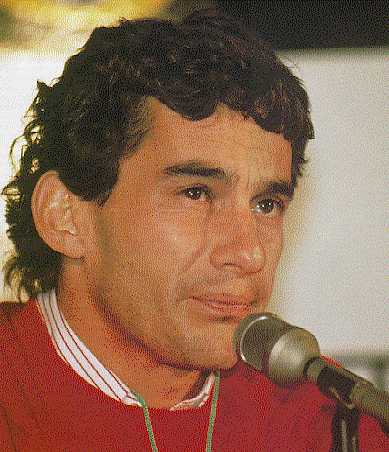
For 1990 Ayrton was joined by Gerhard Berger at McLaren. 10 pole positions signalled that Ayrton was back on top form and determined to regain the title. He won six times that year, also appearing on the podium a further five times. A retirement in Spain left Prost with a chance of beating Senna to the championship, this time in Japan it was Prost who needed the points. Ayrton drove into the back of Prost at the first corner forcing both cars out of the race. Senna had regained the title, but received a great deal of criticism for the manner in which it had finally been decided. For many people it was repayment for the events of the Japanese GP a year earlier.
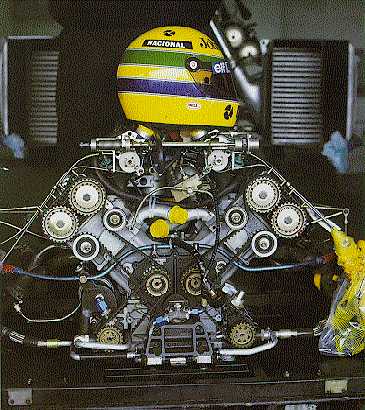 In
1991 we were treated to a display of driver and car in perfect
harmony. Ayrton effectively won the championship in the first half
of the season, four straight wins and two third places left him
clear of the pack. Also he had finally won the Brazilian GP. The
Williams challenge did not start until Mexico and Mansell put
together a string of three wins. Ayrton won in Hungary and Belgium
and with a second place in Italy he looked set for his third
title. With Mansell failing to score points in Portugal Ayrton
went to Spain with a 25 point lead. That was cut to 17 points by
Japan, however Mansell spun off and with that Ayrton was World
champion again. He would be only the fifth driver to retain the
title, a select club to which he rightly belonged. Ayrton's joy at
regaining the title allowed him a gesture of generosity and at the
last corner of the Japanese GP he allowed his team mate Gerhard
Berger to go through and score his first win for McLaren. The last
race of the season was the rain shortened Australian GP, half
points meant that Ayrton won the title by 24 points. By 1992 the
Honda engine was no longer the most coveted engine in the pit
lane. Williams had refined their car and Renault had produced a
brilliant engine. For the first time since 1987 Ayrton was only
able to qualify on pole once in a season. He did manage three
wins, a fifth at Monaco to equal Graham Hill's record, and in
Hungary and Italy. No one could compete with Mansell in the
Williams though and Ayrton finished fourth in the championship.
1993 saw McLaren move to Ford engines, Alain Prost rejoined
Williams and everyone expected him to walk away with the title.
Ayrton had different ideas, his brilliance in the wet allowed him
to put on a masterful display winning in the rain in Brazil and at
Donnington.
In
1991 we were treated to a display of driver and car in perfect
harmony. Ayrton effectively won the championship in the first half
of the season, four straight wins and two third places left him
clear of the pack. Also he had finally won the Brazilian GP. The
Williams challenge did not start until Mexico and Mansell put
together a string of three wins. Ayrton won in Hungary and Belgium
and with a second place in Italy he looked set for his third
title. With Mansell failing to score points in Portugal Ayrton
went to Spain with a 25 point lead. That was cut to 17 points by
Japan, however Mansell spun off and with that Ayrton was World
champion again. He would be only the fifth driver to retain the
title, a select club to which he rightly belonged. Ayrton's joy at
regaining the title allowed him a gesture of generosity and at the
last corner of the Japanese GP he allowed his team mate Gerhard
Berger to go through and score his first win for McLaren. The last
race of the season was the rain shortened Australian GP, half
points meant that Ayrton won the title by 24 points. By 1992 the
Honda engine was no longer the most coveted engine in the pit
lane. Williams had refined their car and Renault had produced a
brilliant engine. For the first time since 1987 Ayrton was only
able to qualify on pole once in a season. He did manage three
wins, a fifth at Monaco to equal Graham Hill's record, and in
Hungary and Italy. No one could compete with Mansell in the
Williams though and Ayrton finished fourth in the championship.
1993 saw McLaren move to Ford engines, Alain Prost rejoined
Williams and everyone expected him to walk away with the title.
Ayrton had different ideas, his brilliance in the wet allowed him
to put on a masterful display winning in the rain in Brazil and at
Donnington.
Donnington 93 - His Finest Hour?
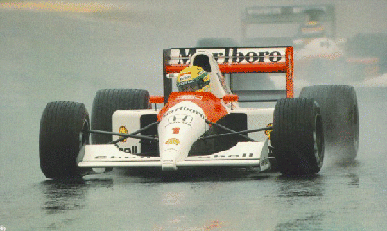 At
Donnington Senna was at his brilliant best, surging past four cars
on the opening lap. Another win in Monaco (a record sixth win) put
Ayrton in the lead for the championship after six rounds. From
Canada to Germany (four races) Prost won every time while Ayrton
only managed one fourth place and two fifth place finishes.
At
Donnington Senna was at his brilliant best, surging past four cars
on the opening lap. Another win in Monaco (a record sixth win) put
Ayrton in the lead for the championship after six rounds. From
Canada to Germany (four races) Prost won every time while Ayrton
only managed one fourth place and two fifth place finishes.
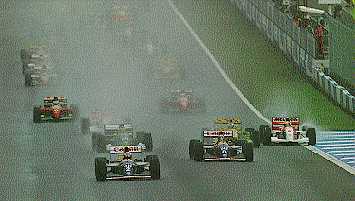 (click the picture
for the mpeg movie)
(click the picture
for the mpeg movie)
The brilliance of his driving could not make up for the deficiencies in his equipment. Another wet race in Japan levelled the playing field somewhat and again Ayrton won. The final race in Australia was to be McLaren's last victory, Ayrton secured his only pole of the season and led (except for pit stops) from start to finish. He finished second in the championship 16 points and about 100 bhp behind Alain Prost.
1994 was a title for the taking. For the second time in succession Williams had lost a world champion to retirement from F1. Prost followed Mansell out of F1 and with Senna in a class of his own and driving a Williams, it was not a question of would he win the title, more a question of how many races would it take. The season started as expected, Ayrton on pole position for the first race in Brazil. Ayrton led for the first 21 laps but lost first place to Schumacher during his pit stop, trying to catch the flying German he spun off and stalled his engine. The next race was the Pacific GP at Aida, again Ayrton secured pole position, this time however Hakkinen collided with him at the first corner and he spun out. Two races, two poles, no finishes and no points. The next race was at San Marino, once again Ayrton secured pole, this time however the meeting was marred by the death of the young Simtek driver Roland Ratzenberger. On race day I remember Ayrton giving an interview where he said that the first two races would have to be written off and he said "our season starts now, 14 races instead of 16". The race got underway and almost immediately it was stopped. JJ Lehto failed to get away from the grid and Pedro Lamy ploughed into the back of the stationary car. At the restart Ayrton got away in the lead, he led for five laps before his car crashed into the retaining wall at the Tamburello curve, a curve which would have been taken at around 160 mph and the same curve that Gerhard Berger had crashed into some years before. It is still not known why his car crashed, there is a great deal of debate about the steering column which was modified before the race. As the camera panned in on the stricken Williams the stillness of the driver meant that something was wrong. GP drivers usually leap out of their cars and Ayrton was motionless, for a brief second he moved and millions of viewers heaved a collective sigh of relief. Sadly Ayrton was killed in the crash, his car withstood the impact brilliantly and all his safety equipment withstood the huge forces but his front suspension had been forced back towards his head under the force of the impact and it was this which proved fatal. He was pronounced dead in a Bologna hospital later that afternoon. Ayrton was undoubtedly the greatest driver of his age, his record is outstanding. In 10 seasons and three races he secured 68 pole positions out of 87 front row starts (a record unlikely to be broken), 41 wins, 19 fastest laps and 614 points from 161 races. He holds the record for the most laps in the lead with 2981, comfortably ahead of second place Prost with 2712 (who had 38 more races) Were it not for the events of May 1st 1994 he would probably be challenging for a record sixth world championship.
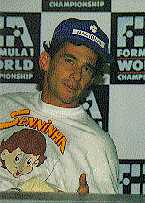
"If I ever happen to have an accident that eventually costs me
my life, I hope it is in one go. I would not like to be in a
wheelchair. I would not like to be in a hospital suffering from
whatever injury it was. If I am going to live, I want to live
fully. Very intensely, because I am an intense person. It would
ruin my life if I had to live partially."
......Ayrton Senna, taken from Car magazine
 .
.

Ayrton Senna da Silva 21st March 1960 - 1st May 1994 RIP
Drivers World Championships: 3
Grand Prix Wins: 41
Pole Positions: 65
........ this last statistic is that yard-stick by which
all drivers in an era are gauged, after all "the stop-watch
never lies" - if your best lap time was any where near Ayrton's
you were doing well!! ..... actually 65
poles is more than twice that achieved by any rival
(& a percantge only approached by Jim Clark ... click here for an in-car movie of
Ayrton's Monaco Pole Lap